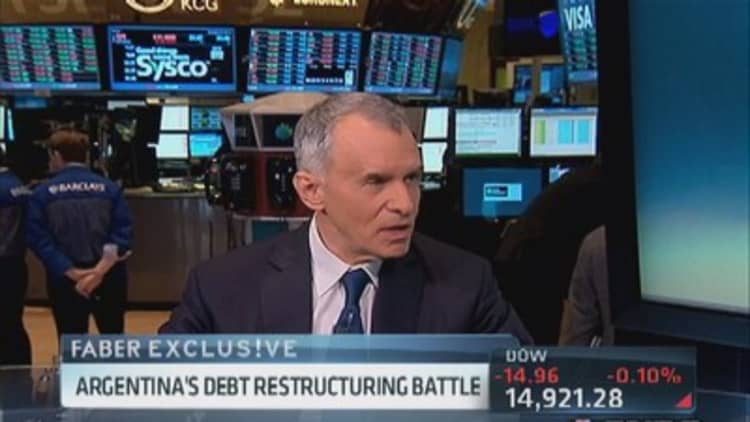Argentina's exchange rate on Thursday suffered its steepest daily decline since the country's devastating 2002 financial crisis, extending the previous day's losses as the central bank gave up its battle against the peso's decline.
Having shed more than 30 percent of its reserves last year, the central bank this week abandoned its policy of supporting the peso by intervening in the foreign exchange market.
The new policy set the stage for Thursday's loss in the value of the currency and increased worries about what is already one of the world's highest inflation rates.
(Read more: Investing in Argentina? Get ready to cry)
The peso-dollar interbank exchange rate hit the 8 mark, down 11 percent on the day following a 3 percent decline on Wednesday. Argentina's black market peso fell 7.25 percent on Thursday to close at 13.1 per dollar.
"Yesterday the central bank neither bought nor sold dollars, which tells you what its position is with respect to the exchange rate," cabinet chief Jorge Capitanich told reporters on Thursday.
Central bank reserves stood at $29.44 billion.
On Thursday the bank intervened but by an inconsequential $100 million, according to local foreign exchange traders.
(Read more: Goldman: Cut your emerging markets exposure by a third)
Due to local currency controls, the black market is the only way for many Argentines to get their hands on dollars as confidence in Latin America's No. 3 economy falls and inflation soars. Given the country's history of repeated financial crises, Argentines like to save in dollars.

According to private analysts, consumer prices rose more than 25 percent in 2013, although discredited official data clocks inflation at less than half that.
Unorthodox policies, from currency controls meant to stop capital flight to heavy stimulus spending unencumbered by inflation targeting, have made Argentina a no-go zone for all but the most risk-hungry investors.
Argentina's key grains sector has cut exports as farmers hoard their crops rather then expose themselves to the swooning local currency. This has contributed to the scarcity of dollars that is debilitating the peso.
(Read more: Next emerging market sell-off may be time to pounce)
Every time President Cristina Fernandez tightens capital controls in a bid to shore up the country's wobbly balance of payments, it increases the scramble for dollars. This in turn contributes to the fall in the value of the black market peso and higher inflation.
The new year has begun with analysts expecting a 30 percent rise in consumer prices in 2014. That would be the highest rate since 2002, when millions of middle class Argentines were pushed into poverty by a crisis punctuated by a sovereign bond default and 41 percent inflation.

